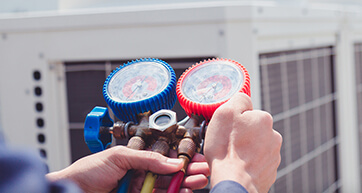It can be hard to deal with hot weather, and turning up the air conditioning may seem like the only solution. However, this isn’t your only option for keeping your home cool. More importantly, there are ways to keep your home comfortable that use less energy.
We’ll show you how to balance the temperature inside your home and save energy by pointing out important factors and possible answers for the temperature settings in your home.
Optimizing your temperature settings based on the season can substantially reduce your energy expenses and improve the comfort of your rooms.
During summer, the Department of Energy suggests a setting of 78 degrees F when you’re home and 85 degrees when you’re away. By raising your thermostat by a few degrees, you can minimize unnecessary cooling. If the temperature still feels too warm, adjust it by 1 to 2 degrees. For maximum savings, change the setting to 82 degrees, or for optimal sleep, set it between 60 to 67 degrees at night. It’s worth noting that children and senior citizens may sleep better at slightly higher temperatures.
In winter, to maximize energy efficiency, the recommended indoor temperature is 68 degrees when you’re home, and it can be lowered when you’re away.
For cost-effectiveness, it’s recommended to set your thermostat to 68 degrees in winter and 78 degrees in summer. If you have a mini-split system, you can personalize the temperature for each room according to usage and individual comfort needs. These ductless systems are perfect for cooling your entire home, an attic, an addition, or even a garage, allowing you to avoid cooling rooms that are not in use.
Consistent thermostat settings are crucial for maintaining comfortable room temperatures and enhancing your home’s energy efficiency. While it might be tempting to turn off your AC when you’re not home, bear in mind that this will require extra energy to re-cool your rooms upon your return. Also, setting your AC to a colder temperature doesn’t make it cool your rooms faster.
The position of your thermostat can directly impact the accuracy of temperature readings and overall energy consumption. To prevent random activation, it’s best to place it away from windows, doors, direct sunlight, and vents. Ideal spots are on interior walls in frequently used spaces. It’s worth noting that certain thermostats may not be compatible with heat pumps, so it’s advisable to consult HVAC specialists for special thermostat designs.
The short answer is yes; adjusting your home’s temperature based on the season can significantly enhance your energy savings.
During the summer, the main challenge is to lower the indoor temperatures. This can be accomplished by opening windows and doors to increase airflow, all while ensuring that indoor air quality isn’t compromised. To warm your home during winter, consider improving your insulation and sealing drafts in windows and doors.
There are several other methods to maintain comfortable temperatures indoors without having to depend solely on your HVAC system. Using a ceiling fan or a portable fan can enhance your room’s comfort.
Other recommendations include:
Additional strategies include installing weather stripping to seal out heat, adding solar panels, running heat-generating appliances at night, and opening windows at night to allow natural cooling.
Implementing the strategies listed above can make a noticeable difference in both your home’s comfort levels and energy bills. AIS Heating & Air Conditioning is dedicated to providing superior AC services to homes in Fremont and Livermore, accommodating all brands.
Our certified technicians are reliable, trustworthy, and experts in their field. Let us support you with all your home comfort needs!
Request an energy audit in Livermore today by calling AIS at (510) 792-4328.
